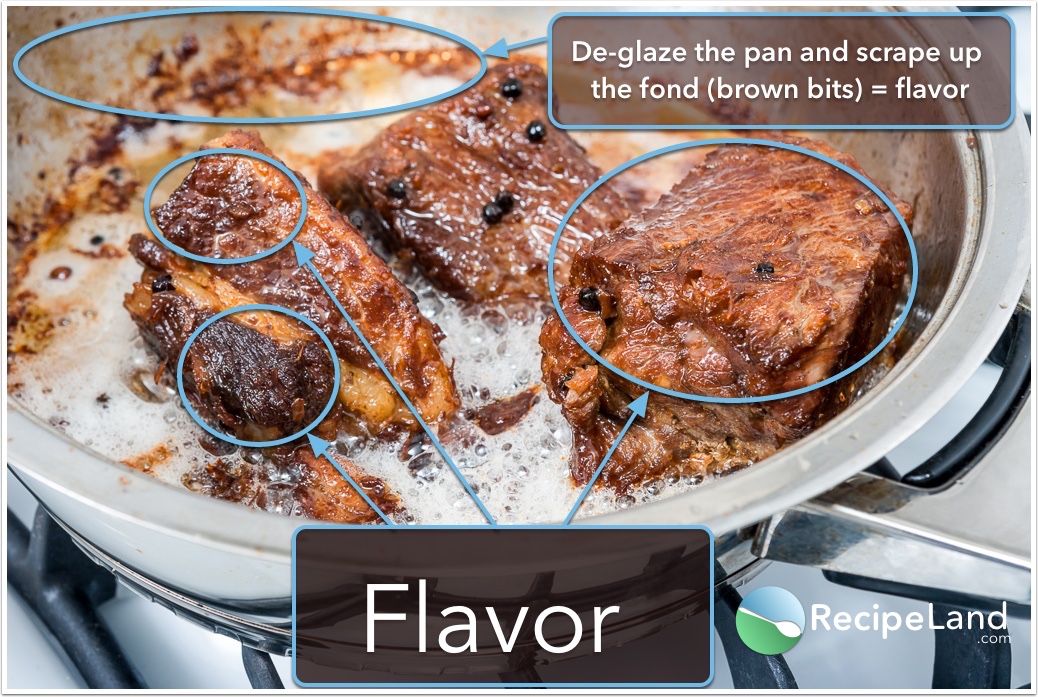SEAR-ious Flavor

Louis Camille Maillard (1878-1936) was a French physician and chemist. In 1912 he was researching how amino acids combined to form proteins. Serendipitously, he uncovered
Contents
Louis Camille Maillard (1878-1936) was a French physician and chemist. In 1912 he was researching how amino acids combined to form proteins. Serendipitously, he uncovered the basic chemistry behind something man had been doing since the discovery of fire: searing meat with intense heat.
(For the purposes of our discussion, meat refers to any animal protein). In the culinary world, this is now known as the Maillard reaction.
The Maillard reaction is a type of browning reaction, so named for the dark brown color imparted to the food. Browning reactions are extremely complex chemical transformations that result from exposing food to high heat.
It does NOT seal in the juices, as the common culinary myth holds. What browning meat does is create intense flavor.
To produce a browning reaction, the heat must be above 300 degrees. Since water cannot be heated above 212, boiled, poached and simmered foods will never brown. Steam can go above 212 degrees if under pressure.
So unless you have a means of positioning your porterhouse in a turbine engine, dry heat methods are the way to go. This means roasting, broiling, grilling, sautéing and frying.
(Even though oil is in "liquid" form, frying is still a dry heat method. More on that in a future frying article). The balancing act with dry heat methods is to cook the center of your food to the proper doneness before the outside burns.
The larger the item, the more likely the exterior will burn before the heat has penetrated the center sufficiently. We want to sear the surface of our food, not incinerate it. (I'm using the term "sear" loosely.
Technically, searing is browning food in fat and thus, by the book, would only apply to sautéing and frying). Here's how to brown your food via each of the dry heat cooking methods.
Roasting
The method of choice for large items such as a whole chicken or turkey, or a beef roast. The heat in an oven is provided by convection, i.e., circulating air currents.
Convection, not being direct heat, is less harsh. Ergo, foods can roast for extended periods of time and be cooked to perfection inside and out, assuming the correct temperature is maintained.
Generally, the larger the item, the lower the roasting temperature. Given the correct temperature, all you need to do is place the food in the oven and let nature take its course.
However, some chefs prefer to boost the heat temporarily at the beginning or the end of the cooking to ensure a good sear. If this is your plan, you're better off spiking the heat near the end and you always should have a meat thermometer to ensure you're cooking the center properly.
Broiling
Broiling is not direct heat but cooking via infrared radiation. However, the heat source is extremely hot and in close proximity to the food. Thick items are not appropriate for broiling.
Again, you will obliterate the outside by the time the center is cooked. Broiling is better suited to steaks as opposed to roasts, chicken cut into pieces, chops, and even some fish. If your food is a little on the thick side then move it further from the broiler.
Grilling
Ah! One of the best thermal methods for that ultimate sear. This is why grilling is so popular. Grilling is intense, direct heat.
But again, if your steak is very thick, or your chicken breast is on the bone, you can transform the surface into an ashtray while the centre is still a bacteria-fest.
For large items, start them on a hot part of the grill, sear them, and then move them to a cooler part of the grill or on the rack above it to finish. Thin items aren't an issue unless they're too thin. Then you get the opposite problem: the center is overcooked by the time a proper sear is produced.
Sautéing
Make sure the pan has fully heated first. Add the cooking fat, allow it to heat up and then add the food. It should sizzle when it hits the pan. Flip after the first side is seared.
The second side will not take as long. If the item is more than an inch thick, you may need to finish it in the less intense heat of the oven to prevent burning the exterior.
Frying
Watch the temperature of the oil. It varies with the food but 375 is almost always the max with most items cooked in the 325-350 range. Here again, very large items are not appropriate.
In all of these methods:
the food should be at room temperature at the onset of cooking, heat the cooking vessel and/or oil fully before introducing the food, do not move the food until the one side has seared, and brushing the meat lightly with oil before cooking will facilitate even browning.
Comments